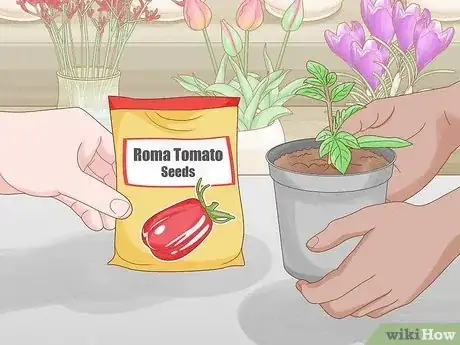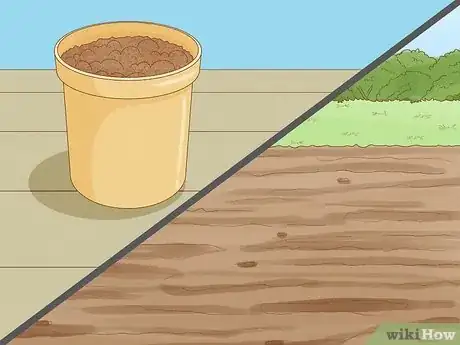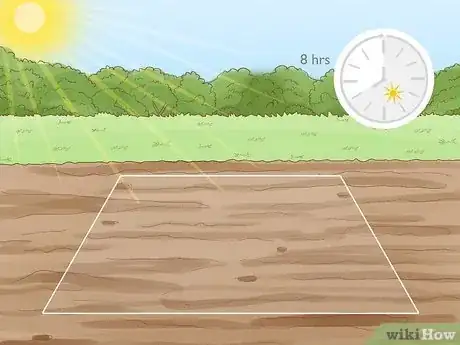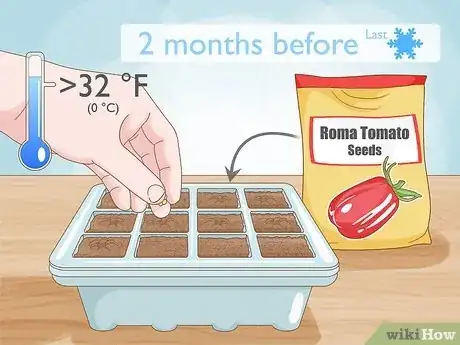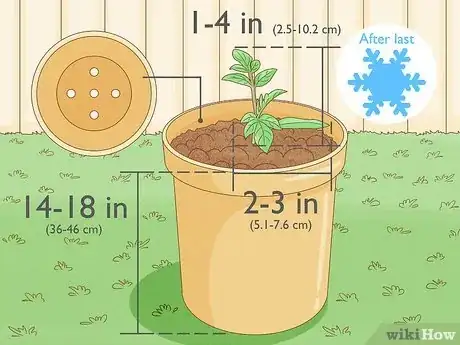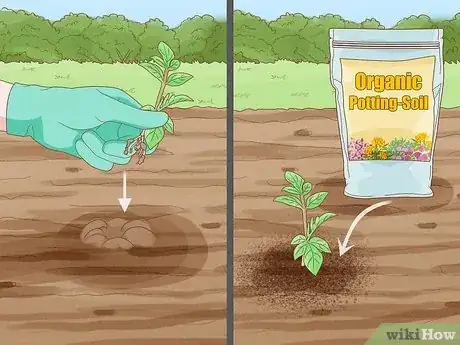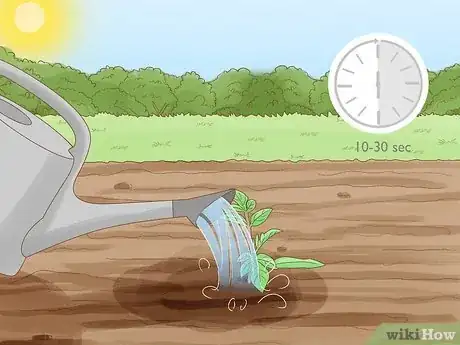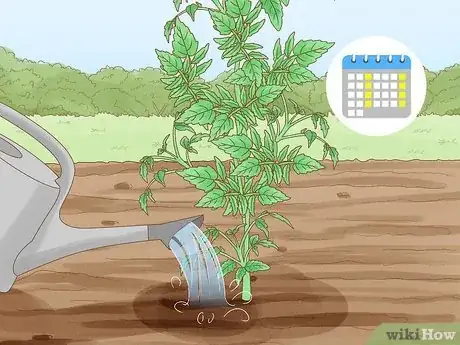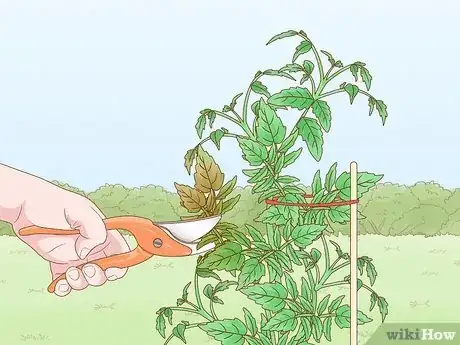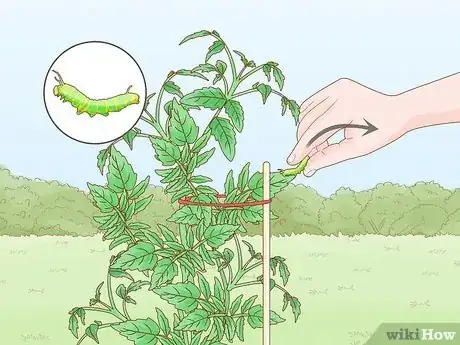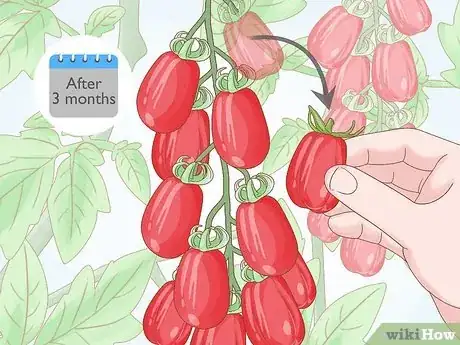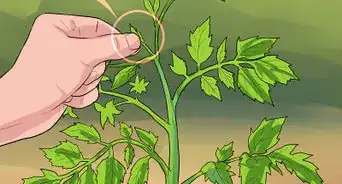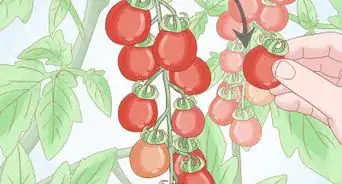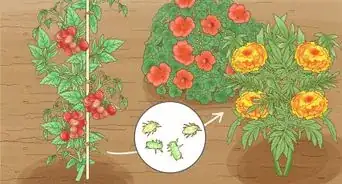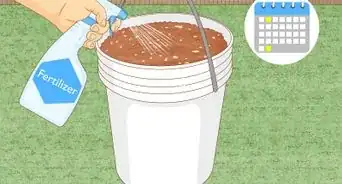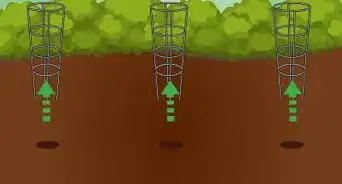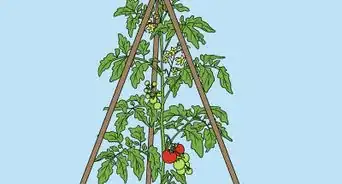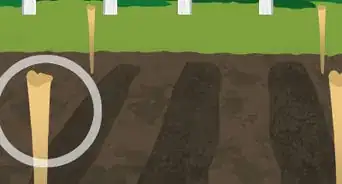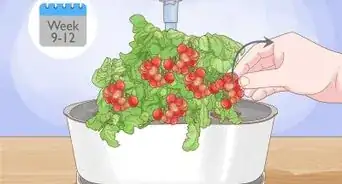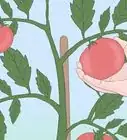This article was co-authored by Monique Capanelli. Monique Capanelli is a Plant Specialist and the Owner and Designer for Articulture Designs, an innovative design firm and boutique in Austin, Texas. With over 15 years of experience, Monique specializes in interior botanical design, living walls, event decor, and sustainable landscape design. She attended the University of Texas at Austin. Monique is a Certified Permaculture Designer. She provides plant and botanical design experiences, from small gifts to entire transformations, to shoppers as well as commercial clients including Whole Foods Market and The Four Seasons.
This article has been viewed 37,171 times.
The Roma tomato is a plump, sweet tomato known for its low water content and chewy inside. It is popularly used to make tomato paste and for canning purposes. To grow Roma tomatoes, first get seeds or seedlings and pick a sunny spot. You can either grow Roma tomatoes in your garden bed or inside containers. After the last frost date, place your tomato in a hole or in your pot, cover it with soil, and water it every 2-3 days. With a little effort and upkeep, you can easily grow Roma tomatoes!
Steps
Choosing Your Plants and Grow Spot
-
1Get your seeds or seedlings from a local nursery or garden center. Visit a garden center to get your plants. If you have 2-3 months before your last frost date, you can easily grow seedlings. If it is 1-4 weeks from your frost date, seedlings are a better choice.[1]
- To find a garden center near you, search online.
-
2Choose to grow your roma tomatoes in your garden or from pots. If you have room in your garden, grow your tomatoes in the soil. If you don’t have a garden bed or have run out of room, consider putting your tomatoes inside well-drained containers.[2] It is a good idea to use five or seven gallons felt garden pots because they allow a lot of aeration.[3]
- You can grow healthy plants with either option.
Advertisement -
3Pick a sunny spot with 8+ hours of direct sunlight a day. Before you plant your tomatoes, make sure you have a spot outside that gets ample direct sunlight. If planting them in your garden, pick a spot with minimal shade coverage. If planting them in containers, you can easily move your plants into the sun.[4]
- Tomatoes require lots of sunlight to grow juicy crops.
Growing Roma Tomatoes
-
1Start growing your seeds indoors 2 months before your last frost date. Tomato seeds take about 8 weeks to germinate. If you want to start them from seeds, plant them in your containers so they can grow into seedlings before spring strikes.[5]
- Your frost date is the average day when temperatures reach above 32 °F (0 °C).
-
2Plant your seedlings in a pot or outdoors after the last frost date. To determine your frost date, visit https://www.almanac.com/gardening/frostdates and type in your zip code. Then, dig a hole in your garden that is the size of your plant's root system. The root system of a tomato plant is usually around 1–4 in (2.5–10.2 cm) long and 2–3 in (5.1–7.6 cm) wide. You can eyeball the size of yours when determining the size of your hole. If growing them in containers, use a 14–18 in (36–46 cm) pot with 1-5 drainage holes and fill the pot up with organic potting soil.[6]
- Space your tomatoes 2 ft (0.61 m) apart if growing them outside. Tomato plants grow best with a bit of space in between.
- Grow 1 seedling per container if growing plants in pots.
-
3Place a tomato cage around the hole or inside of your pot. When growing Roma tomatoes, use a tomato cage to reinforce the plant’s structure as it grows. This way, your plant grows vertical rather than horizontal. To use, stick the posts of the cage inside the dirt if growing them outside. The plant should be in the center of the cage. If growing them inside, place the bottom of the cage inside the container and fill dirt around it.[7]
- You want your plants to grow upwards so they can produce juicy tomatoes. This also helps the tomatoes get adequate sunlight.
-
4Place your seedling into the hole and cover it with organic potting soil. If you need to make a bit of room, use your fingers or a garden tool to create a wider hole. Then, place the root of your tomato plant into the soil. Bury it one inch deeper in the soil for sturdier growth.[8] Center your tomato plant inside of your container if using one. Then, scoop up some organic potting soil with your garden tool, and pour it over the base of the plant.[9]
- Adding soil on top helps the plant take to its new home.
- Organic potting soil provides rich, vital nutrients to your tomato plants.
-
5Water the plant right away to reduce the shock to its root system. After you’ve planted your tomato plants, use your garden hose or a watering can to saturate the roots. Pour water over the base of your plant for 10-30 seconds until it is moist.[10]
- Giving your plants water right away helps the roots take to the soil and start to grow in its new location.
Caring for Your Tomatoes
-
1Water your tomato plant every 2-3 days to keep it hydrated. Tomatoes require regular watering to stay healthy. Use either your garden hose or a watering can, and saturate the base of the plant when the soil goes dry.[11]
- Avoid oversaturating your soil.[12] The soil won’t drain properly if there is too much water, and this can cause your plant to rot.
-
2Fertilize your plants every 1-2 weeks using natural products. Always use organic ingredients with your Roma tomatoes to produce the healthiest plants possible. Organic fertilizer is made from animal and vegetable matter. Every week or so, sprinkle a bit of fertilizer over the base of your plant. You can also use compost to feed your tomatoes. [13]
- Do this before you water them for best results. The water helps the fertilizer absorb into the roots.
-
3Prune away withered leaves or discolored areas as needed. With Roma tomatoes, pruning is not required. However, you can trim around the plant to get rid of any less-than-ideal areas. If you see any brown or yellow leaves, snip them off with pruning shears. Do this as well if you see any wilted leaves or flowers.[14]
- Avoid trimming too much of your plant. It may not yield as many tomatoes.
- Trimming off damaged leaves helps your plant retain nutrients.
-
4Watch out for bright green caterpillars and pick them off if you see any. Roma tomatoes as a whole are hearty, durable plants. Sometimes, caterpillars known as tomato hornworms dwell in tomato plants looking for a feast. Keep an eye out for their bright green color. If you spy the bugs, simply pick them up and gently toss them elsewhere in your garden.[15]
- Hornworms are generally harmless, though they will eat your tomato leaves, making your plants look ragged.
-
5Harvest your tomatoes after about 3 months. Your tomatoes will all ripen around the same time after roughly 70-80 days. Pluck them from the plant when the tomatoes are firm, heavy, and entirely red. Use your hands and gently pull them off of the plant.[16]
- Tomatoes start to turn red when the temperature is consistently above 80–85 °F (27–29 °C).
- If you want to make salsas or sauces, harvest your tomatoes when they are bright red and very firm.
- Let your tomatoes ripen a few days longer if you want to can your tomatoes. Pick them when they look dark red and slightly squishy.
Expert Q&A
-
QuestionWhich type of pot is best for growing tomatoes?
 Monique CapanelliMonique Capanelli is a Plant Specialist and the Owner and Designer for Articulture Designs, an innovative design firm and boutique in Austin, Texas. With over 15 years of experience, Monique specializes in interior botanical design, living walls, event decor, and sustainable landscape design. She attended the University of Texas at Austin. Monique is a Certified Permaculture Designer. She provides plant and botanical design experiences, from small gifts to entire transformations, to shoppers as well as commercial clients including Whole Foods Market and The Four Seasons.
Monique CapanelliMonique Capanelli is a Plant Specialist and the Owner and Designer for Articulture Designs, an innovative design firm and boutique in Austin, Texas. With over 15 years of experience, Monique specializes in interior botanical design, living walls, event decor, and sustainable landscape design. She attended the University of Texas at Austin. Monique is a Certified Permaculture Designer. She provides plant and botanical design experiences, from small gifts to entire transformations, to shoppers as well as commercial clients including Whole Foods Market and The Four Seasons.
Plant Specialist Tomatoes do well in a deep and high soil base. It is best to use five or seven gallons felt garden pots to grow tomatoes because they allow a lot of aeration.
Tomatoes do well in a deep and high soil base. It is best to use five or seven gallons felt garden pots to grow tomatoes because they allow a lot of aeration. -
QuestionWhat should I do to have a sturdier growth?
 Monique CapanelliMonique Capanelli is a Plant Specialist and the Owner and Designer for Articulture Designs, an innovative design firm and boutique in Austin, Texas. With over 15 years of experience, Monique specializes in interior botanical design, living walls, event decor, and sustainable landscape design. She attended the University of Texas at Austin. Monique is a Certified Permaculture Designer. She provides plant and botanical design experiences, from small gifts to entire transformations, to shoppers as well as commercial clients including Whole Foods Market and The Four Seasons.
Monique CapanelliMonique Capanelli is a Plant Specialist and the Owner and Designer for Articulture Designs, an innovative design firm and boutique in Austin, Texas. With over 15 years of experience, Monique specializes in interior botanical design, living walls, event decor, and sustainable landscape design. She attended the University of Texas at Austin. Monique is a Certified Permaculture Designer. She provides plant and botanical design experiences, from small gifts to entire transformations, to shoppers as well as commercial clients including Whole Foods Market and The Four Seasons.
Plant Specialist If you bury the stalk of the tomato plant one inch deeper than usual, it will have sturdier stalk growth and a better root system.
If you bury the stalk of the tomato plant one inch deeper than usual, it will have sturdier stalk growth and a better root system. -
QuestionDo tomatoes need a lot of water?
 Monique CapanelliMonique Capanelli is a Plant Specialist and the Owner and Designer for Articulture Designs, an innovative design firm and boutique in Austin, Texas. With over 15 years of experience, Monique specializes in interior botanical design, living walls, event decor, and sustainable landscape design. She attended the University of Texas at Austin. Monique is a Certified Permaculture Designer. She provides plant and botanical design experiences, from small gifts to entire transformations, to shoppers as well as commercial clients including Whole Foods Market and The Four Seasons.
Monique CapanelliMonique Capanelli is a Plant Specialist and the Owner and Designer for Articulture Designs, an innovative design firm and boutique in Austin, Texas. With over 15 years of experience, Monique specializes in interior botanical design, living walls, event decor, and sustainable landscape design. She attended the University of Texas at Austin. Monique is a Certified Permaculture Designer. She provides plant and botanical design experiences, from small gifts to entire transformations, to shoppers as well as commercial clients including Whole Foods Market and The Four Seasons.
Plant Specialist Tomatoes are sufficiently drought tolerant, so you should not overwater them.
Tomatoes are sufficiently drought tolerant, so you should not overwater them.
Things You’ll Need
- Roma tomato seeds or seedlings
- Potting soil
- Container
- Garden space
- Fertilizer
- Tomato cage
- Water
- Pruning shears
Warnings
- Avoid planting your Roma tomatoes too early. Check a frost calendar online and look at your weather forecast before you decide to plant. If you plant them too early, they may not grow as healthy as possible.⧼thumbs_response⧽
- Do not place your tomatoes near a windowsill to ripen. This can cause them to rot before they are fully ripe.⧼thumbs_response⧽
- Do not refrigerate your fresh tomatoes, as this ruins the texture and flavor.⧼thumbs_response⧽
References
- ↑ https://www.gardeningchannel.com/growing-roma-tomatoes/
- ↑ https://www.youtube.com/watch?v=71RPAlcAFbI
- ↑ Monique Capanelli. Plant Specialist. Expert Interview. 22 September 2020.
- ↑ https://www.attainable-sustainable.net/roma-tomatoes/
- ↑ https://www.gardeningchannel.com/growing-roma-tomatoes/
- ↑ https://www.gardeningchannel.com/growing-roma-tomatoes/
- ↑ https://www.almanac.com/plant/tomatoes
- ↑ Monique Capanelli. Plant Specialist. Expert Interview. 22 September 2020.
- ↑ https://youtu.be/I78Cz9toWcw?t=4m36s
- ↑ https://www.almanac.com/plant/tomatoes
- ↑ https://www.attainable-sustainable.net/roma-tomatoes/
- ↑ Monique Capanelli. Plant Specialist. Expert Interview. 22 September 2020.
- ↑ https://www.attainable-sustainable.net/roma-tomatoes/
- ↑ https://www.attainable-sustainable.net/roma-tomatoes/
- ↑ https://www.attainable-sustainable.net/roma-tomatoes/
- ↑ https://www.attainable-sustainable.net/roma-tomatoes/
- ↑ https://www.attainable-sustainable.net/roma-tomatoes/
